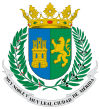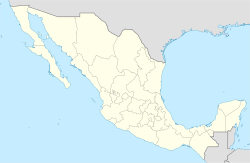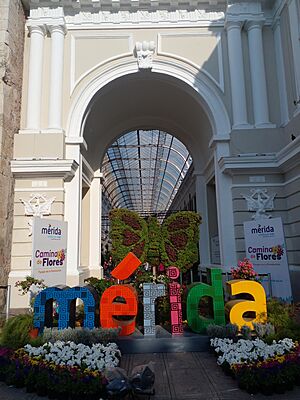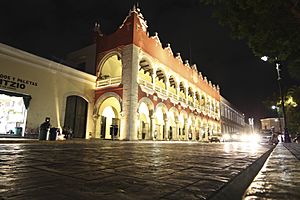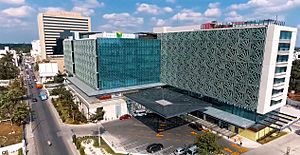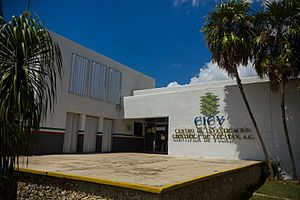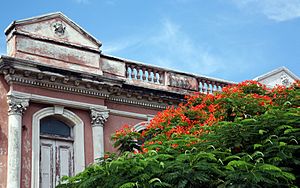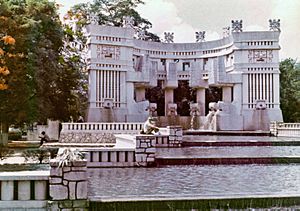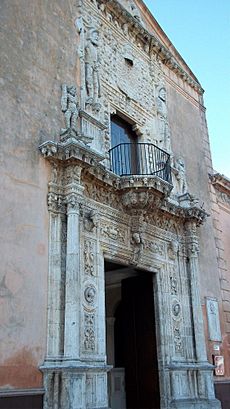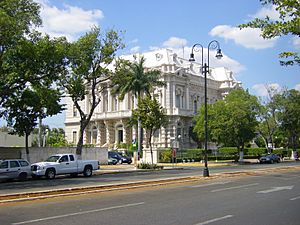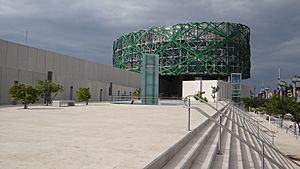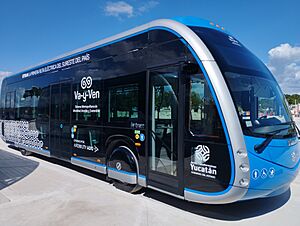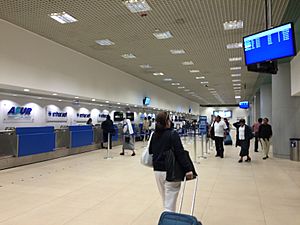Mérida, Yucatán facts for kids
Quick facts for kids
Mérida
|
|||
|---|---|---|---|
|
City
|
|||
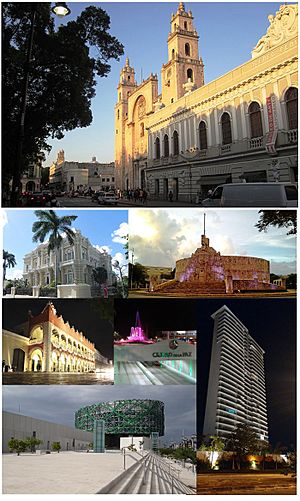
Above, from left to right: San Ildefonso Cathedral, the Canton Palace, the Monument to the Fatherland, the Municipal Palace, the Glorieta de la Paz, the Great Museum of the Maya World and a view of the Country Towers.
|
|||
|
|||
| Nickname(s):
"La Ciudad Blanca" (The White City)
|
|||
| Country | Mexico | ||
| State | Yucatán | ||
| Municipality | Mérida | ||
| City founded | January 6, 1542 | ||
| Elevation | 10 m (30 ft) | ||
| Population
(2022)
|
|||
| • Total | 1,201,000 (Metro) | ||
| • Rank | 34th in North America 12th in Mexico |
||
| Demonym(s) | Meridiano | ||
| GDP (PPP, constant 2015 values) | |||
| • Year | 2023 | ||
| • Total | $26.1 billion | ||
| • Per capita | $21,400 | ||
| Time zone | UTC−6 (CST) | ||
| Postal code |
97000
|
||
| Area code(s) | 999 | ||
| Major airport | Mérida International Airport | ||
| IATA Code | MID | ||
| ICAO Code | MMMD | ||
| INEGI Code | 310500001 | ||
| Climate | Aw | ||
Mérida is the capital city of the Mexican state of Yucatán. It is the largest city in southeastern Mexico. The city is located on the Yucatán Peninsula, about 35 kilometers (22 miles) inland from the Gulf of Mexico. In 2020, Mérida had a population of 921,770 people. Its larger metropolitan area, which includes nearby cities like Kanasín and Umán, had about 1,316,090 people.
Mérida is also the main cultural and financial center of the Yucatán Peninsula. The city has a rich history, blending Maya and Spanish cultures. For example, the Cathedral of Mérida, Yucatán was built in the late 1500s using stones from old Maya ruins. It is the oldest cathedral on the mainland of the Americas. Mérida has one of the largest old town districts on the continent. It was the first city to be named an American Capital of Culture, and it has received this special title twice.
Mérida is known as one of the safest cities in Mexico and even in the Americas. In 2015, it was recognized as an International Safe Community. Forbes magazine has listed Mérida three times as one of the best cities in Mexico to live, invest, and do business. In 2022, the UN-Habitat said Mérida had the highest quality of life in Mexico.
Contents
- Why Mérida is Called "The White City"
- Mérida's Past: A Look at its History
- Mérida's Location and Environment
- How Mérida is Governed
- Mérida's Economy
- Science and Technology in Mérida
- Mérida's Rich Culture
- Top Places to See in Mérida
- Sports in Mérida
- Getting Around Mérida: Transportation
- Education in Mérida
Why Mérida is Called "The White City"
Mérida was named after Mérida, Spain. The Spanish explorers who founded the city thought the Maya ruins at the site of Ti'ho looked like the Roman ruins in Spain. Over time, Mérida became known as "La Ciudad Blanca" (The White City).
This nickname likely comes from the white limestone used to paint the buildings in the city's old colonial areas. From space, Mérida looks like a large whitish area surrounded by the green forests of the Yucatán Peninsula. Other cities in Latin America also share this nickname for similar reasons.
There's also an old story that says the Spanish only allowed white-skinned Europeans to live inside the city walls for safety. However, the old arches at the city's entrance, which were supposedly built for this reason, were actually constructed much later, almost 150 years after the city was founded. Also, indigenous troops who helped the Spanish lived in neighborhoods within the city.
Mérida's Past: A Look at its History
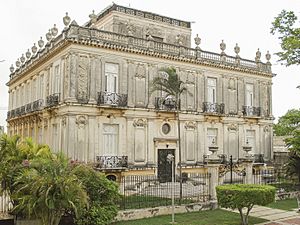
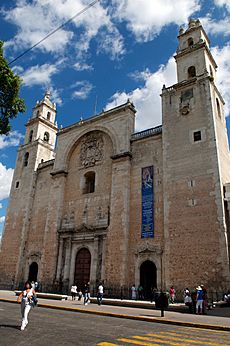
Mérida was founded in 1542 by Spanish conquistadors, including Francisco de Montejo the Younger. It was built on the site of an ancient Maya city called Ti'ho. This Maya city was also known as Ichkanzihóo, meaning "City of Five Hills," because of its pyramids.
Many carved stones from the old Maya ruins of Ti'ho were used to build the first Spanish buildings in Mérida. You can still see these stones in the walls of the main cathedral today. For many years, Mérida was a walled city. This helped protect the Spanish settlers from occasional revolts by the local Maya people.
In the late 1800s, the area around Mérida became rich from growing henequen. This plant's fiber was used to make rope and twine. At the start of the 1900s, factories in Mérida mainly made tobacco, molasses, rum, soap, and leather goods. Korean immigrants also arrived in 1905 to work on the henequen plantations around Mérida.
Over the years, Mérida has hosted important events. In 1993, Pope John Paul II visited the city. It has also been the site of two major meetings between the United States and Mexico, in 1999 and 2007. These meetings led to the creation of the Mérida Initiative, a plan for security cooperation. In 2014, Mérida hosted the VI Summit of the Association of Caribbean States. The city has also welcomed big sports events, like the Archery World Cup, and scientific conferences, such as the International Cosmic Ray Conference.
Mérida's Location and Environment
Mérida is located in the northwest part of the state of Yucatán. To the north, you'll find Progreso and the Gulf of Mexico. To the east are Valladolid and Tizimín, while Celestún is to the west. The city of Campeche is to the southwest. Many important Maya archaeological sites are nearby, including Chichen Itza, Uxmal, Oxkintok, Sayil and Kabah.
The city is located near the center of the Chicxulub Crater, which was formed by an asteroid impact long ago. The land in Mérida is very flat, only about 10 meters (30 feet) above sea level. Outside the city, the land is covered with small trees and former henequen fields. There is almost no surface water, but many cenotes (natural sinkholes with underground water) are found in the area.
Mérida has a historic downtown area, called centro histórico, which is typical of old Spanish cities. The streets are laid out in a grid pattern. Odd-numbered streets run east–west, and even-numbered streets run north–south. Calles 60 and 61 surround the "Plaza Grande" in the city's heart. The wealthier neighborhoods are usually in the north, and the most crowded areas are in the south.
Mérida's Climate
Mérida has a tropical savanna climate. This means it's generally hot, with moderate to high humidity depending on the time of year. The average high temperature for the year is about 33.5°C (92.3°F). Temperatures can often go above 38°C (100°F) in May. Low temperatures range from 17.2°C (63.0°F) in January to 21.7°C (71.1°F) in May. Mérida is often a few degrees hotter than coastal areas because it's inland. The rainy season lasts from June through October. During this time, tropical storms can also affect the area.
| Climate data for Mérida (1951–2010) | |||||||||||||
|---|---|---|---|---|---|---|---|---|---|---|---|---|---|
| Month | Jan | Feb | Mar | Apr | May | Jun | Jul | Aug | Sep | Oct | Nov | Dec | Year |
| Record high °C (°F) | 39.5 (103.1) |
39.5 (103.1) |
42.0 (107.6) |
43.0 (109.4) |
44.2 (111.6) |
42.0 (107.6) |
40.0 (104.0) |
43.0 (109.4) |
40.0 (104.0) |
39.0 (102.2) |
39.0 (102.2) |
39.5 (103.1) |
44.2 (111.6) |
| Mean daily maximum °C (°F) | 30.8 (87.4) |
31.5 (88.7) |
34.0 (93.2) |
35.6 (96.1) |
36.3 (97.3) |
35.3 (95.5) |
35.0 (95.0) |
34.9 (94.8) |
34.2 (93.6) |
32.7 (90.9) |
31.5 (88.7) |
30.6 (87.1) |
33.5 (92.3) |
| Daily mean °C (°F) | 24.0 (75.2) |
24.4 (75.9) |
26.3 (79.3) |
27.9 (82.2) |
29.0 (84.2) |
28.5 (83.3) |
28.2 (82.8) |
28.1 (82.6) |
27.9 (82.2) |
26.8 (80.2) |
25.4 (77.7) |
24.0 (75.2) |
26.7 (80.1) |
| Mean daily minimum °C (°F) | 17.2 (63.0) |
17.3 (63.1) |
18.6 (65.5) |
20.2 (68.4) |
21.7 (71.1) |
21.6 (70.9) |
21.4 (70.5) |
21.3 (70.3) |
21.6 (70.9) |
20.8 (69.4) |
19.3 (66.7) |
17.5 (63.5) |
19.9 (67.8) |
| Record low °C (°F) | 9.2 (48.6) |
9.5 (49.1) |
9.0 (48.2) |
10.0 (50.0) |
10.0 (50.0) |
10.0 (50.0) |
10.0 (50.0) |
10.0 (50.0) |
10.0 (50.0) |
10.0 (50.0) |
10.0 (50.0) |
7.0 (44.6) |
7.0 (44.6) |
| Average rainfall mm (inches) | 38.4 (1.51) |
32.2 (1.27) |
22.5 (0.89) |
24.4 (0.96) |
69.4 (2.73) |
138.3 (5.44) |
158.7 (6.25) |
140.7 (5.54) |
183.1 (7.21) |
127.9 (5.04) |
56.2 (2.21) |
45.1 (1.78) |
1,036.9 (40.82) |
| Average rainy days (≥ 0.1 mm) | 4.2 | 3.3 | 2.3 | 1.9 | 4.6 | 10.8 | 13.4 | 12.8 | 13.9 | 9.7 | 5.4 | 4.3 | 86.6 |
| Average relative humidity (%) | 70 | 68 | 63 | 64 | 63 | 71 | 72 | 73 | 76 | 75 | 75 | 73 | 70 |
| Mean monthly sunshine hours | 208.6 | 205.9 | 241.8 | 254.1 | 273.2 | 231.0 | 246.1 | 247.9 | 208.5 | 218.5 | 212.4 | 201.8 | 2,749.8 |
| Source 1: Servicio Meteorologico Nacional (humidity 1981–2000) | |||||||||||||
| Source 2: NOAA (sun 1961–1990) | |||||||||||||
How Mérida is Governed
Mérida is the capital of the state of Yucatán. This means that the main government offices for the state are in the city. These include the offices of the governor of Yucatán, the Congress of Yucatán (where laws are made), and the Superior Court of Justice.
The city itself is run by a City Council, called the Ayuntamiento. This council meets at the Municipal Palace in the historic center. The City Council is led by a mayor, also known as a municipal president. There are also other members called regents and trustees.
Mérida's Economy
The Yucatán Peninsula, especially Mérida, is a great place for economic growth. Many people and companies choose to invest here. This has helped Yucatán's economy grow much faster than the rest of Mexico.
The World Bank Group also recognized Mérida for how easy it is to start a business. It ranked Mérida fourth in Mexico for this category.
Science and Technology in Mérida
Mérida is home to important research centers. These include:
- The Yucatan Scientific Research Center (CICY)
- A unit of the Center for Research and Advanced Studies (CINVESTAV Unidad Mérida)
- The Dr. Hideyo Noguchi Regional Research Center (CIR-UADY)
- The Yucatán Science and Technology Park (PCYTY)
- The Peninsular Center for Humanities and Social Sciences (CEPHCIS) of the National Autonomous University of Mexico (UNAM)
These centers help advance knowledge in many fields, from science to social studies.
Mérida's Rich Culture
Mérida has been named the American Capital of Culture twice, in 2000 and 2017. As the state capital, Mérida is a lively cultural hub. It has many museums, art galleries, restaurants, movie theaters, and shops. The city has kept many of its beautiful colonial buildings. Music and dancing are a big part of daily life. At the same time, Mérida is a modern city with shopping malls, hotels, and fun places to visit.
The famous avenue, Paseo de Montejo, is lined with unique sculptures. Each year, the MACAY Museum in Mérida displays new sculptures from Mexico and another chosen country. These exhibits stay for 10 months.
Mérida and Yucatán have a special culture because they were somewhat separated from the rest of Mexico by geography. The Spanish tried to change Maya traditions, but the Maya culture was very strong. You can still see Maya influences every day in how people speak, dress, and in their stories.
A great example is Hanal Pixan, a Maya and Catholic celebration of the Day of the Dead. It happens on November 1st and 2nd. Families create special altars for their deceased relatives. These altars mix Christian symbols like crucifixes with skull decorations and food offerings. Múkbil pollo, a Maya tamal pie, is traditionally offered to the dead on this day. Many people in Yucatán enjoy eating this dish around the Day of the Dead.
For English speakers, Mérida has the Mérida English Library. It's a lending library with many English books, videos, and children's books. It's also a place for cultural events and storytelling. Mérida is also home to the Yucatán Symphony Orchestra, which performs classical music, jazz, and opera at the José Peón Contreras Theatre.
Delicious Yucatecan Food
Yucatán food is unique and different from what most people think of as "Mexican" food. It mixes local Maya cuisine with Caribbean, Mexican, European, and Middle Eastern influences. Tropical fruits like coconut, pineapple, and tamarind are often used in Yucatán dishes.
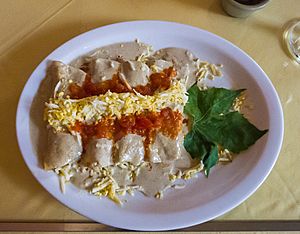
Here are some popular regional dishes:
- Poc Chuc: A Maya/Yucatecan style of boiled or grilled pork.
- Salbutes and Panuchos: Salbutes are soft tortillas with lettuce, tomato, turkey, and avocado. Panuchos are fried tortillas filled with black beans, topped with turkey or chicken, lettuce, avocado, and pickled onions.
- Queso Relleno: A fancy dish with ground pork inside a hollowed-out edam cheese ball, served with tomato sauce.
- Pavo en Relleno Negro (also called Chimole): Turkey stew cooked with a black paste made from roasted chiles.
- Sopa de Lima: A lime soup with chicken broth, often served with shredded chicken or turkey and crispy tortilla strips.
- Papadzules: Egg tacos covered in a pumpkin seed sauce and tomatoes.
- Cochinita pibil: A famous marinated pork dish from Yucatán, made with achiote. Achiote is a reddish spice with a special flavor.
- Bul keken (Mayan for "beans and pork"): A traditional black bean and pork soup, often eaten on Mondays.
- Brazo de reina (Spanish for "The Queen's Arm"): A traditional tamal dish. It's a long, flat tamal filled with ground pumpkin seeds, rolled up, sliced, and topped with tomato sauce.
- Tamales colados: A traditional dish made with pork or chicken, banana leaf, fresh corn dough, and achiote paste.
Achiote is a popular spice here. It comes from the hard annatto seed found in the region. The seeds are ground with other spices to make a reddish seasoning paste called recado rojo.
Hot sauce in Mérida is usually made from local chiles like Chile Xcatik, Chile Seco de Yucatán, and Chile Habanero.
Language and Accent in Mérida
The Spanish spoken in Yucatán sounds different from Spanish in other parts of Mexico. This is because it is strongly influenced by the Yucatec Maya language, which is spoken by many people in the state. The Maya language has a melodic sound and special "sh" sounds.
Even though many people speak Maya, there has been some negative feeling about it. Older generations might have been seen as having higher status if they knew the language, but younger people sometimes felt it was a disadvantage. This was also linked to social and economic status.
Because Yucatán was somewhat isolated by the Caribbean Sea and the Gulf of Mexico, Yucatecan Spanish has kept many words that are no longer used elsewhere. However, with modern transportation and technology like radio and TV, the culture and language of the rest of Mexico are slowly becoming more common.
Besides Maya, many students in Yucatán now choose to learn English, which is taught in most schools.
Top Places to See in Mérida
Historic Sites to Explore
Modern Mérida has grown far beyond its original city walls. However, you can still see many old Spanish colonial buildings and city gates in the centro histórico (historic center). This area is one of the largest in the Americas. Many grand homes from the early 1900s line the main avenue called Paseo de Montejo. For example, "Las Casas Gemelas" (The Twin Houses) are two beautiful French and Spanish style mansions built in 1911. Some of these old buildings are being restored and used as offices or homes today.
Other important historic sites in the city include:
- Antiguo convento de Nuestra Señora de la Consolación (Nuns) (1596)
- Barrio y Capilla de Santa Lucía (1575)
- Barrio y Templo Parroquial de San Cristóbal (1796)
- Barrio y Templo Parroquial de San Sebastián (1706)
- Barrio y Templo Parroquial de Santa Ana (1733)
- Barrio y Templo Parroquial de Santiago (1637)
- Capilla de Nuestra Señora de la Candelaria (1706)
- Capilla y parque de San Juan Bautista (1552)
- Casa de Montejo (1549)
- Catedral de San Ildefonso (1598), the first on the American continent.
- Iglesia del Jesús o de la Tercera Orden (Third Order) (1618)
- Las Casas Gemelas (The Twin Houses) (1911)
- Monumento à la Patria (1956)
- Palacio de Gobierno (1892)
- Templo de San Juan de Dios (1562)
Cultural Centers for Learning and Fun
- Centro Cultural Andrés Quintana Roo: Located in Santa Ana, it has galleries and hosts artistic events.
- Centro Cultural Olimpo: Next to the Municipal Palace in the Plaza Grande.
- Casa de la Cultura del Mayab: This is where the Casa de Artesanías (house of handcrafts) is located, in downtown Mérida.
- Centro Estatal de Bellas Artes (CEBA): Offers classes in painting, music, theater, ballet, jazz, and dance.
- Centro Cultural del Niño Yucateco (CECUNY): In Mejorada, this 16th-century building offers classes and workshops especially for kids.
- Centro Cultural Dante: A private center inside one of Mérida's main bookstores.
Museums to Visit
- Gran Museo del Mundo Maya: Yucatán's Maya Museum, showing the history and identity of Yucatán.
- Museo de Antropología e Historia "Palacio Cantón": Yucatán's history and archaeology museum.
- Museo de Arte Contemporáneo Ateneo de Yucatán (MACAY): In the city center, next to the cathedral. It has permanent and changing art exhibits.
- Museo de la Canción Yucateca Asociación Civil: Honors famous Yucatecan musicians.
- Museum of the City of Merida: Located in the old post office building, it displays important items from the Spanish colonial and Pre-Columbian eras.
- Museo de Historia Natural: A natural history museum.
- Museo de Arte Popular: Shows popular art and handcrafts from different Mexican cultures.
- Museo Conmemorativo de la Inmigración Coreana a Yucatán: A museum about Korean immigration to Yucatán.
Major Theaters with Regular Shows
- Teatro José Peón Contreras
- Teatro Daniel Ayala Pérez
- Teatro Mérida (now Teatro Armando Manzanero)
- Teatro Colón
- Teatro Universitario Felipe Carrillo Puerto
- Teatro Héctor Herrera
Sports in Mérida
Mérida has several places where you can play sports:
- Estadio Salvador Alvarado: In the city center.
- Unidad Deportiva Kukulcán: Includes the major football stadium (Carlos Iturralde), the Kukulcan Baseball Park, and the Polifórum Zamná arena.
- Complejo deportivo La Inalambrica: In the west, with archery facilities that hosted a world championship.
- Unidad deportiva Benito Juarez Garcia: In the northeast.
- Gimnasio Polifuncional: Home to the professional basketball team Mayas de Yucatán.
| Team | Sport | League | Stadium |
|---|---|---|---|
| Leones de Yucatán | Baseball | Mexican Baseball League | Parque Kukulkán |
| Venados F.C. | Football | Liga de Expansión MX | Estadio Carlos Iturralde |
The city also hosts the Mérida Marathon every year since 1986.
Getting Around Mérida: Transportation
Bus Services
Bus service in Mérida is provided by several local companies. The buses are often as good as or better than those in bigger cities like Guadalajara or Mexico City. Some even have air conditioning.
As of 2024, the city is changing its bus system to a new municipal system called "Va y Ven." The Ie-Tram Yucatán is a new fast bus system that started in December 2023.
The main bus terminal (CAME) offers first-class and luxury bus services to most cities in southern Mexico outside Yucatán. Shorter routes within the state are served by smaller terminals, mostly downtown.
Taxi Services
Several groups offer taxi services. Some taxis use meters, but most charge a flat rate based on your destination. You can find taxis at specific spots, wave them down on the street, or call for one by radio.
Another type of taxi is called "Colectivo." These taxis work like small buses, following a set route and charging a small fare. They usually carry 8 to 10 people. Ride-sharing apps like Uber, DiDi, and inDrive also offer services in Mérida.
Air Travel
Mérida is served by Manuel Crescencio Rejón International Airport (IATA: MID, ICAO: MMMD). This airport has daily flights to major cities in Mexico, including Mexico City, Monterrey, and Cancún. It also has international flights to Miami, Houston, Havana, and Toronto. In 2007, over 1.3 million passengers used this airport.
Train Service
Mérida used to be a central point for a large railway network that operated in Yucatán and Campeche. This system started in 1902.
Today, passenger train service to Mérida is provided by Tren Maya. This train runs from Palenque, Chiapas to Cancún, Quintana Roo, and then to Playa del Carmen. It stops at the Teya Mérida railway station, about 8 kilometers (5 miles) east of the city.
Major Roads
Here are the main roads connecting Mérida:
- Mérida-Progreso (Federal 261): This 33-kilometer (21-mile) road with 8 lanes connects Mérida to Progreso, Yucatán's largest port city.
- Mérida-Umán-Campeche (Federal 180): Connects Mérida with the city of San Francisco de Campeche.
- Mérida-Kantunil-Cancún (Federal 180): A four-lane road that becomes a toll road at Kantunil. It links Mérida to Chichén Itzá, Valladolid, and Cancún.
- Mérida-Tizimín (Federal 176): Connects Mérida with Tizimín, the second-largest city in Yucatán.
- Mérida-Teabo-Peto (Mundo Maya Road): Used for the "convent route" and as a link to the ancient Maya city of Mayapán and Chetumal.
Education in Mérida
In 2000, Mérida had many schools: 244 preschools, 395 elementary schools, 136 junior high schools, 97 high schools, and 16 universities or higher education schools. Mérida's public schools have been known for good performance since 1996. All students in Mexico must attend school from age 6 to 15. After that, they can choose to continue their education.
However, the quality of education can vary across the city, often depending on the social and economic background of the area. Indigenous Maya communities sometimes face challenges in education. While laws aim to ensure bilingual education for indigenous populations, these programs are not always available after elementary school. This can make it hard for Maya children to continue their studies if they are forced to learn only in Spanish.
Here are some of the state universities and institutions in Mérida:
- Universidad Autónoma de Yucatán (UADY)
- Universidad Tecnológica Metropolitana (UTM)
- Instituto Tecnológico de Mérida (ITM)
- Escuela Superior de Artes de Yucatán (ESAY)
- Universidad Pedagógica Nacional
- Escuela Normal Superior de Yucatán (ENSY)
- Universidad Nacional Autónoma de México Mérida satellite campus (UNAM)
- Universidad Politécnica de Yucatán (UPY)
There are also several private institutions:
- Centro de Estudios Superiores CTM (CESCTM)
- Colegio de Negocios Internacionales (CNI)
- Universidad Anáhuac Mayab
- Universidad Marista
- Centro de Estudios Universitarios del Mayab (CEUM)
- Universidad Modelo
- Universidad Interamericana para el Desarrollo (UNID)
- Centro Educativo Latino (CEL)
- Universidad Interamericana del Norte
- Centro Universitario Interamericano(Inter)
- Universidad Mesoamericana de San Agustin (UMSA)
- Centro de Estudios de las Américas, A.C. (CELA)
- Universidad del Valle de Mexico (UVM)
- Instituto de Ciencias Sociales de Mérida (ICSMAC)
- Universidad Popular Autónoma de Puebla, Plantel Mérida (UPAEP Mérida)
Mérida also has several national research centers, including:
- Centro de Investigacíón Científica de Yucatán (CICY)
- Centro de Investigaciones Regionales Dr. Hideyo Noguchi, which does biological and medical research.
- Centro INAH Yucatán, focused on studies of anthropology, archaeology, and history.
- Centro de Investigación y de Estudios Avanzados CINVESTAV/IPN
 In Spanish: Mérida (México) para niños
In Spanish: Mérida (México) para niños



